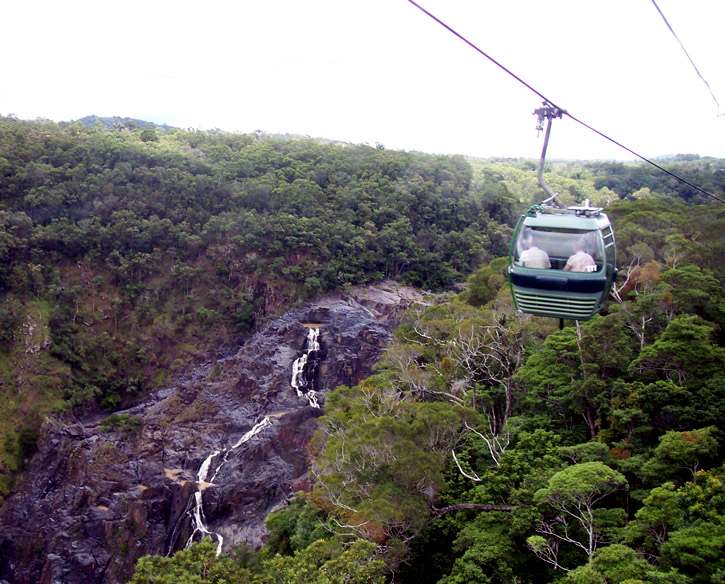Quaint, colorful Kuranda is a day trip worth its while. Nestled in the mountain range separating Cairns from the tableland, this little village is bustling and brimming with things to do and see. From art galleries to markets, from animal experiences to hikes, Kuranda is like a vacation from your vacation. And it’s not just a destination—the journey there and back is just as exciting. Going on a cable car across the mountains, looking down on the canopy of the rainforest and even spotting a crocodile sunning itself by the river, is a treat in itself, but if you take the cable car to Kuranda, you’ll get two treats in one. Then there is the historic railway, which also goes to Kuranda and back to Cairns, making it a three-in-one day trip.

Take a cable car up over the rainforest’s canopy on your way to Kuranda. Photo © Leonora Enking, licensed Creative Commons Attribution Share-Alike.
Look out for pavement art, interesting benches and street signs, and sculptures dotted around the village.I suggest taking the cable car on the way out before it gets too sunny and hot; you might still get the mist settled above the canopy. On the way back you can relax on the train journey, have a drink, have a snack, and enjoy the views down the steep embankments. Mixing it up and taking both the cable car and the train as modes of transport makes your day out extra special.The village is a hive of activity between 9am and 3pm; after that, shops and cafés close, and tourists drift away. Originally settled by the Djabugay people, who called the place Ngunbay, or “place of the platypus,” Kuranda was first surveyed in 1888 for the building of the railway and road that were to connect the new seaport of Cairns with the people across the mountain range.
With the establishment of the railway, Kuranda soon became a vacation and honeymoon hot spot for local couples, who took the train through the forest and stayed in the pretty village and visited the Barron Gorge. Alexander Graham Bell spent a vacation here back in June 1910. As the president of the National Geographic Society, he tried to promote an understanding of distant lands through pictures in an age when travel—especially to a far-flung place such as Australia’s tropical north—was a privilege of only a few.
Tourism truly took off in 1915 and reached its peak in the 1930s. In the 1960s, “hippy” communes flourished in the region, so abounding with natural beauty that made it easy to pursue an alternative lifestyle. Today’s artistic community is left over from that time and has established a thriving art hub that attracts visitors from around the globe.
Art is prevalent all over the village. Look out for pavement art, interesting benches and street signs, and sculptures dotted around the village. Even the fences are decorated.
Excerpted from the First Edition of Moon Sydney & the Great Barrier Reef.